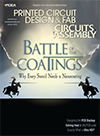News
ESSEX, UK – EMS provider Brantham Engineering Ltd. has added a 4,500 sq. ft. facility for raw materials and component storage, the company announced.
The addition brings the company's total manufacturing space to more than 41,000 sq. ft.
The addition brings the company's total manufacturing space to more than 41,000 sq. ft.
EL SEGUNDO, CA – After six months of domination by the once unknown brand Vizio Inc., the North American LCD-TV market in the fourth quarter saw the return of more established names to the top sales ranks, says iSuppli Corp.
For the quarter, LCD-TV shipments in North America rose 41% sequentially to 7.9 million units. Plasma set demand rose 36% to 1.3 million units.
Samsung Electronics became the No. 1 seller of LCD-TVs in North America, with its unit shipment market share rising to 14.2%, up from 12.8% in the third quarter. The company was ranked No. 2 in the third quarter.
Meanwhile, Sony increased its share to 12.5% in the fourth quarter, up from 10.8% sequentially, good for the No. 2 spot in North America, up from No. 4 during the previous quarter, says the research firm.
Vizio, which had shocked the North American television market with its rise to No. 1 in the second and third quarters, fell to third with a 12.4%, down from 13% sequentially.
Vizio had risen to the top spot because of a combination of low pricing and high visibility sales channels. However, Samsung and Sony struck back in the fourth quarter, according to iSuppli.
“Samsung and Sony employed very aggressive pricing and promotion strategies to take advantage of the key holiday buying season,” said Riddhi Patel, principal analyst, television systems for iSuppli.
He added, “Consumers in the television industry are not as brand conscious as they once were, as evidenced by the popularity of Vizio,” Patel said. “However, when the difference in pricing between a value-brand television and a premium-brand set is within the 10% range, consumers often will go for the premium brand.”
Panasonic padded its dominance of the plasma market with a share of 37.1%, a 9.
AUSTIN, TX – Applications for 3-D TSV, including image sensors, flash, DRAM, processors, FPGAs and power amplifiers, will be adopted, but the timing for mass production depends on how the cost compares with that of existing technologies, says TechSearch International in a new report.
Image sensors for camera modules are already in volume production, but for other applications, the adoption time is longer than originally predicted, as is common with the introduction of many new technologies, the company says. Design, thermal and test issues remain a barrier to TSV adoption in some applications, though progress is being made.
The report, “Through Silicon Via Technology: The Ultimate Market for 3D Interconnect,” provides a timeline for the adoption of TSV in these applications. The report forecasts market size in units and number of wafers for each application area.
Driven by the need for improved performance and reduced timing delays, methods have been developed to use short vertical interconnects instead of the long interconnects used in 2-D structures. The industry is moving past the feasibility (R&D) phase for TSV technology and into commercialization, where economic realities will determine which technologies are adopted, says the firm. Low-cost fine via hole formation and reliable via filling technologies have been demonstrated; process equipment and materials are available.
Image sensors for camera modules are already in volume production, but for other applications, the adoption time is longer than originally predicted, as is common with the introduction of many new technologies, the company says. Design, thermal and test issues remain a barrier to TSV adoption in some applications, though progress is being made.
The report, “Through Silicon Via Technology: The Ultimate Market for 3D Interconnect,” provides a timeline for the adoption of TSV in these applications. The report forecasts market size in units and number of wafers for each application area.
Driven by the need for improved performance and reduced timing delays, methods have been developed to use short vertical interconnects instead of the long interconnects used in 2-D structures. The industry is moving past the feasibility (R&D) phase for TSV technology and into commercialization, where economic realities will determine which technologies are adopted, says the firm. Low-cost fine via hole formation and reliable via filling technologies have been demonstrated; process equipment and materials are available.
TAIPEI – The world’s No. 3 PC maker, Acer Inc., reported its fourth-quarter net profit was $71.88 million, up 77% year-over-year, with its purchase of Gateway. Profit fell 21.8% sequentially.
BRIDGEWATER, MA – Chase Corp. has named Adam Chase president and chief operating officer.
Chase, grandson of the company’s founder, joined the firm in 1998 and has held the positions of controller, general manager and vice president, among others.
Chase manufactures tapes, laminates, sealants and coatings for high reliability applications, and provides contract assembly services.
Chase, grandson of the company’s founder, joined the firm in 1998 and has held the positions of controller, general manager and vice president, among others.
Chase manufactures tapes, laminates, sealants and coatings for high reliability applications, and provides contract assembly services.
JACKSON, MI – EMS provider Sparton Corp. reported 2008 second-quarter net sales of $55 million, up 3.6% year-over-year. The net loss for the quarter ended Dec. 31 rose to $1.9 million, from $1.4 million in 2006.
Press Releases
- 2026 IEEE Electronic Components and Technology Conference Student Innovation Challenge Pre-registration Deadline Extended to January 11, 2026
- PCBsync PCB Assembly Introduces Full-Scale Electronic Manufacturing Service
- Magic Leap Partners with Pegatron for AR Glasses Components Production
- TEXMAC/Takaya Appoints ARK Mfg. as New Rep in Arizona


